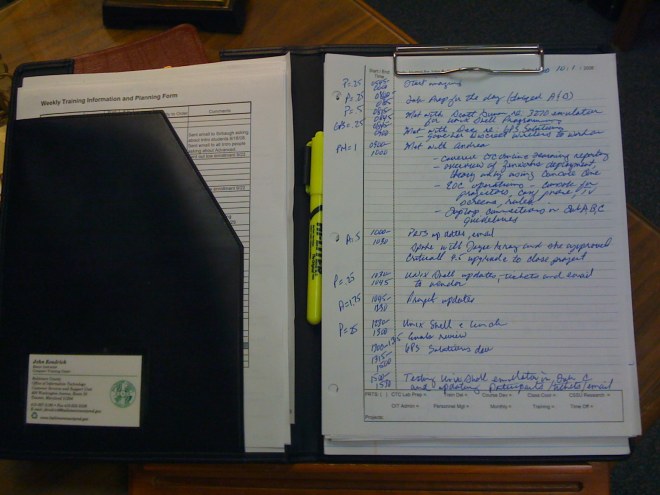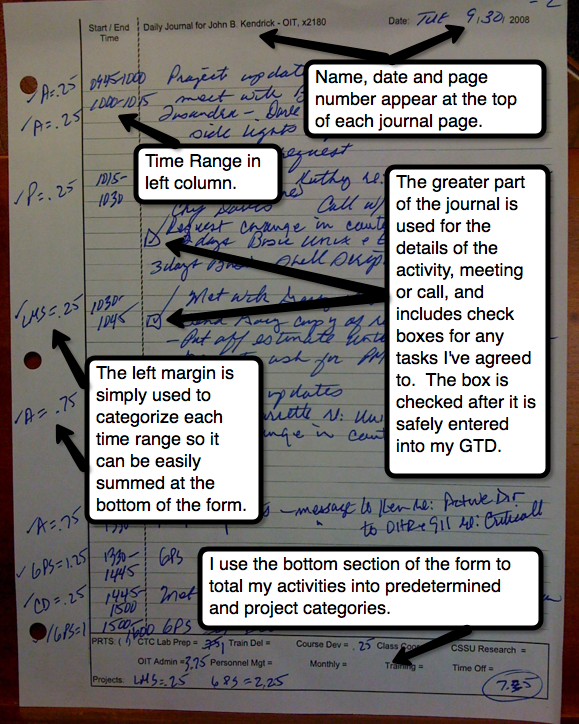I recently wrote an article entitled, How to Get Started with GTD, on this blog. That post was picked up by several of the most popular GTD blogs, including GTDTimes and Did I Get Things Done . . . and generated a great deal of interest. Several readers have requested that I provide more details on a part of that article that discussed the use of a Daily Journal.
To briefly recap, after years as a Covey planner user and trainer, I switched to David Allen’s GTD (Getting Things Done) system early this year and experienced a significant increase in productivity. The switch was all the more dramatic because I traded in my paper-based planning system for Nozbe, an all electronic, online GTD system.
There was one hold over from my paper-based planner that I didn’t give up – the Daily Journal. You can read the details about why I retained it in How to Get Started with GTD. I’ll use the rest of this post to provide details on how I use the Daily Journal to enhance my GTD.
The Journal accomplishes several important things.
- In a minimum of 15 minute increments, document what you did throughout the day. This will provide evidence to yourself that you did, or did not do something productive throughout your day.
- Document the details of your activities throughout the day, who you spoke with, when and about what.
- Document the discussion points of your meetings directly on the journal page, for later reference.
- Write down what you, and others agree to do, in a meeting, on a phone call, or even an idea you come up with when not convenient to put it directly into your system.
- Place a checkbox beside anything that needs to be entered as a task in your GTD. When you get back on the computer, enter each task and check the box indicating that you’ve got it in you’re trusted system.
The Daily Journal Page
The form that I use for this page is simply lined paper with some identifying information at the top, a column to record time on the left side and some space for project information at the bottom of the form. I created a pdf file by scanning some lined paper from my previous planner pages, and then edited it with the information you see at the top and bottom of the page, including the column headings. I simply print copies of the pdf and punch them for a three ring binder prior to their use in my writing pad.
Writing Pad Holder for Journal Pages
The holder I use to carry my journal pages has a spring clip on one side to hold my active journal pages and a flap on the left side to store additional journal pages and business cards.

Storing my Journal Pages
If the meeting or other notes in the journal apply to a project for which I maintain a physical folder, when I return to my office, I make a copy of that page, draw a diagonal line through any unrelated material on that page and place it in the project folder. I always leave my journal pages intact for later reference.
I maintain only the current and past week’s journal pages in the writing pad for reference. As I remove a week’s pages, they are placed in a three ring binder in chronological order with tabs for each month. That way, I can go back to the pages if needed. I have all journal pages stored this way, one notebook per year, back to 2002.


Retrieving Journal Entries
Since journal entries are paper-based, you might wonder how they can be searched for later data retrieval. Two years ago, I was spending inordinate time indexing journal entries in a spreadsheet. Since converting to an electronic GTD, all of my important tasks are already in the system. Now, when I need some crucial detail, I simply search my GTD, and if for some reason I need more information, I simply use the date from the GTD entry to go to the appropriate binder and journal page for all the details.
Hope that clears up the details on the Daily Journal. Remember, this is a crucial component of any planning system, GTD or otherwise, and will prove what you’ve done to be productive throughout your work day; provide documentation of important meetings, conversations, phone calls and thoughts; and provide a simple and effective way of capturing all the details and tasks until you can transfer them into your trusted system.
Ira, a coworker of mine who long ago passed on, used to say, “a short pen is better than a long memory.” He was right, and my journal is that “short pen.” Thanks for reading, John.

[…] ~Journaling Your Way to GTD […]
Wow – So you are basically doing a time inventory everyday along with tracking your other commitments? You would make a good Attorney :-) – or maybe you already are? I can imagine once that is ingrained it could be quite useful. Historically it has been a challenge doing a time inventory for just ONE day for me.
Impressive discipline and quite useful I am sure. It is also interesting to hear from someone that has utilized Seven Habits AND GTD. Reading GTD I constantly could see relationships between Covey’s principle living and habits and the GTD mindset and personally think the two can complement each other.
-Stephen
Thanks for your comments Stephen. And no, I’m not a lawyer, but I have seen much value over the years in documenting the time I spend. I think of it just like budgeting money. Both are limited resources, time even more than money since everyone has the same amount, just 24 hours a day. So to me, tracking time is no different than tracking money.
I manage an IT training center and there have been occasions throughout my career when management has asked me to tell them what I do. Because I have documented my work by time, it is easy to compile that kind of list whenever it is requested. And recently, our organization has required all but its top level managers to keep a time sheet each week documenting the time spent on production support and specific project work for resource allocation purposes. It was rough for many in our organization to start that discipline, but mine was already very much a part of my work life, so it wasn’t a big change for me.
And I agree, Covey and GTD can coexist. Just use the higher level principals from Covey to plan, manage and prioritize your life, and apply GTD to handle the daily tasks and one can remove much stress in their life. John
[…] link for this week is a great post from upcoming GTD Blogger John Kendrick. The post is titled Journaling your way to GTD and is well worth the time […]
Great post. I do the same thing only I use David Seah’s Emergent Task Planner
as the form for my journal. It gives me space for my hard appointments (patients and students) and space for my “MITs” and plenty more space for everything that comes up. I put them in an archive (simple folder, not organized well) but I am going to change and keep the archives better organized, put them in order in a notebook. Again, great post.
Lynn
I love the idea of marking out anything that needs to be entered as a task in the GTD system, though I prefer checks to checkboxes. Too often journal entries have implicit actions that don’t get identified or extracted.
Dear John,
Thank you so very much for the super-detailed blog post. Ever since you posted the first reference to journaling, I have been visualising (almost fantasizing) of having my own journal and comfortably noting my activities down. You’ve explained everything very clearly to a great level of detail. No further questions for now, but I foresee that I will certainly have them as I begin implementing this system over the next couple of weeks.
John, just one concern, I downloaded the pdf of a sample paper journal more than once. But each time the file appeared incomplete. May I request you to email that pdf to me.
Thanks John. Much appreciate your taking the time out to explain this out.
Really interesting idea, esp. including the time log. I strongly disagree with your approach, though. I’ve seen this with clients, and I recommend against it. The major flaw is “everything in one place.” I find it better to associate notes from project work and meetings on separate dedicated pages. If you want to keep a journal of daily activity, fine. Just don’t put *content* on it. Retrieval is the problem. Say you want to work on a project, so you grab it’s folder and jump in. Only now you have to look up the binder, get it, and flip through possibly multiple pages (because project work might be spread throughout the journal). There go 5-10 minutes right there.
So how to handle your cases? I suggest:
o Activity journal/time log: Dedicated notebook such as yours. Archive by date.
o Conversations: In associated project folder. If none exists (say for a regular general meeting), dedicate a folder to that meeting. Archive by date.
o Marking action: Notate commitments (yours and theirs) for post-meeting processing (see below). I like your checkbox idea. I’ve seen clients highlight, underline, or add an “icon” like a star. I use an “A” in a circle for action, and a “W/F” in a circle for … guess what :-)
o Idea capture: Either on the meeting/project notes, or in your journal if that’s where you like them. I use both, depending on the context. Out for a walk – goes on mini notebook I carry in my man bag (ugly word!). For a meeting, my trusty legal pad.
In all cases afer meetings staple your notes, toss them in your inbox, and process normally, taking care to pull out actions. Check off each to ensure none are missed.
Thanks again for the post. Thoughts?
Thanks for the lengthy reply. To be clear, my project related notes do go in the project folder, while being maintained also in the journal. When I arrive back at my office, I immediately photocopy the journal page with the project notes, draw a line through any non-related information on the page and place that copy in the appropriate project folder, so I don’t have to look up any meeting notes outside of the project folder.
The question might be asked, why keep them in the journal? When I look back in the journal, it helps to give me a perspective of everything that happened and the information collected on that day. I have to admit, that since processing my inbox to zero with GTD, I seldom have to do this anymore. It might just be over doing it on my end, but it really doesn’t take much time, actually within the two-minute rule.
Thank you again for your thoughtful comments and reading. John
[…] the relevant list in RTM. I do also use my trusty notebook when in meetings, using a variant of John Kendrick’s excellent system to record all the action items or questions that come out of my sessions. I’m not perfect, […]